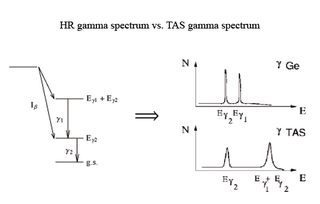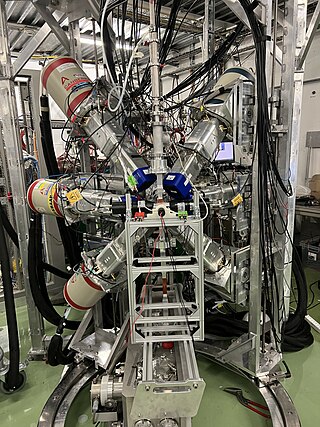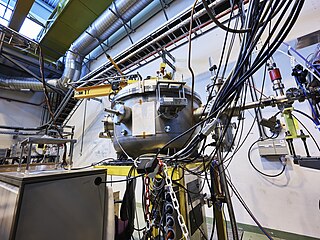
Hassium is a synthetic chemical element; it has symbol Hs and atomic number 108. Hassium is highly radioactive: its most stable known isotopes have half-lives of approximately ten seconds. One of its isotopes, 270Hs, has magic numbers of both protons and neutrons for deformed nuclei, which gives it greater stability against spontaneous fission. Hassium is a superheavy element; it has been produced in a laboratory only in very small quantities by fusing heavy nuclei with lighter ones. Natural occurrences of the element have been hypothesised but never found.

The neutron is a subatomic particle, symbol
n
or
n0
, which has a neutral charge, and a mass slightly greater than that of a proton. Protons and neutrons constitute the nuclei of atoms. Since protons and neutrons behave similarly within the nucleus, they are both referred to as nucleons. Nucleons have a mass of approximately one atomic mass unit, or dalton. Their properties and interactions are described by nuclear physics. Protons and neutrons are not elementary particles; each is composed of three quarks.

Rutherfordium is a synthetic chemical element; it has symbol Rf and atomic number 104. It is named after physicist Ernest Rutherford. As a synthetic element, it is not found in nature and can only be made in a particle accelerator. It is radioactive; the most stable known isotope, 267Rf, has a half-life of about 48 minutes.

Darmstadtium is a synthetic chemical element; it has symbol Ds and atomic number 110. It is extremely radioactive: the most stable known isotope, darmstadtium-281, has a half-life of approximately 14 seconds. Darmstadtium was first created in 1994 by the GSI Helmholtz Centre for Heavy Ion Research in the city of Darmstadt, Germany, after which it was named.

Roentgenium is a synthetic chemical element; it has symbol Rg and atomic number 111. It is extremely radioactive and can only be created in a laboratory. The most stable known isotope, roentgenium-282, has a half-life of 120 seconds, although the unconfirmed roentgenium-286 may have a longer half-life of about 10.7 minutes. Roentgenium was first created in 1994 by the GSI Helmholtz Centre for Heavy Ion Research near Darmstadt, Germany. It is named after the physicist Wilhelm Röntgen, who discovered X-rays. Only a few roentgenium atoms have ever been synthesized, and they have no practical application.
Livermorium is a synthetic chemical element; it has symbol Lv and atomic number 116. It is an extremely radioactive element that has only been created in a laboratory setting and has not been observed in nature. The element is named after the Lawrence Livermore National Laboratory in the United States, which collaborated with the Joint Institute for Nuclear Research (JINR) in Dubna, Russia, to discover livermorium during experiments conducted between 2000 and 2006. The name of the laboratory refers to the city of Livermore, California, where it is located, which in turn was named after the rancher and landowner Robert Livermore. The name was adopted by IUPAC on May 30, 2012. Five isotopes of livermorium are known, with mass numbers of 288 and 290–293 inclusive; the longest-lived among them is livermorium-293 with a half-life of about 60 milliseconds. A sixth possible isotope with mass number 294 has been reported but not yet confirmed.

Ununennium, also known as eka-francium or element 119, is a hypothetical chemical element; it has symbol Uue and atomic number 119. Ununennium and Uue are the temporary systematic IUPAC name and symbol respectively, which are used until the element has been discovered, confirmed, and a permanent name is decided upon. In the periodic table of the elements, it is expected to be an s-block element, an alkali metal, and the first element in the eighth period. It is the lightest element that has not yet been synthesized.
Moscovium is a synthetic chemical element; it has symbol Mc and atomic number 115. It was first synthesized in 2003 by a joint team of Russian and American scientists at the Joint Institute for Nuclear Research (JINR) in Dubna, Russia. In December 2015, it was recognized as one of four new elements by the Joint Working Party of international scientific bodies IUPAC and IUPAP. On 28 November 2016, it was officially named after the Moscow Oblast, in which the JINR is situated.

In nuclear physics and nuclear chemistry, a nuclear reaction is a process in which two nuclei, or a nucleus and an external subatomic particle, collide to produce one or more new nuclides. Thus, a nuclear reaction must cause a transformation of at least one nuclide to another. If a nucleus interacts with another nucleus or particle and they then separate without changing the nature of any nuclide, the process is simply referred to as a type of nuclear scattering, rather than a nuclear reaction.
Unbibium, also known as element 122 or eka-thorium, is a hypothetical chemical element; it has placeholder symbol Ubb and atomic number 122. Unbibium and Ubb are the temporary systematic IUPAC name and symbol respectively, which are used until the element is discovered, confirmed, and a permanent name is decided upon. In the periodic table of the elements, it is expected to follow unbiunium as the second element of the superactinides and the fourth element of the 8th period. Similarly to unbiunium, it is expected to fall within the range of the island of stability, potentially conferring additional stability on some isotopes, especially 306Ubb which is expected to have a magic number of neutrons (184).

The ISOLDE Radioactive Ion Beam Facility, is an on-line isotope separator facility located at the centre of the CERN accelerator complex on the Franco-Swiss border. Created in 1964, the ISOLDE facility started delivering radioactive ion beams (RIBs) to users in 1967. Originally located at the Synchro-Cyclotron (SC) accelerator, the facility has been upgraded several times most notably in 1992 when the whole facility was moved to be connected to CERN's ProtonSynchroton Booster (PSB). ISOLDE is currently the longest-running facility in operation at CERN, with continuous developments of the facility and its experiments keeping ISOLDE at the forefront of science with RIBs. ISOLDE benefits a wide range of physics communities with applications covering nuclear, atomic, molecular and solid-state physics, but also biophysics and astrophysics, as well as high-precision experiments looking for physics beyond the Standard Model. The facility is operated by the ISOLDE Collaboration, comprising CERN and sixteen (mostly) European countries. As of 2019, close to 1,000 experimentalists around the world are coming to ISOLDE to perform typically 50 different experiments per year.

Total absorption spectroscopy is a measurement technique that allows the measurement of the gamma radiation emitted in the different nuclear gamma transitions that may take place in the daughter nucleus after its unstable parent has decayed by means of the beta decay process. This technique can be used for beta decay studies related to beta feeding measurements within the full decay energy window for nuclei far from stability.
Unbiunium, also known as eka-actinium or element 121, is a hypothetical chemical element; it has symbol Ubu and atomic number 121. Unbiunium and Ubu are the temporary systematic IUPAC name and symbol respectively, which are used until the element is discovered, confirmed, and a permanent name is decided upon. In the periodic table of the elements, it is expected to be the first of the superactinides, and the third element in the eighth period. It has attracted attention because of some predictions that it may be in the island of stability. It is also likely to be the first of a new g-block of elements.
Unbiquadium, also known as element 124 or eka-uranium, is a hypothetical chemical element; it has placeholder symbol Ubq and atomic number 124. Unbiquadium and Ubq are the temporary IUPAC name and symbol, respectively, until the element is discovered, confirmed, and a permanent name is decided upon. In the periodic table, unbiquadium is expected to be a g-block superactinide and the sixth element in the 8th period. Unbiquadium has attracted attention, as it may lie within the island of stability, leading to longer half-lives, especially for 308Ubq which is predicted to have a magic number of neutrons (184).
Unbihexium, also known as element 126 or eka-plutonium, is a hypothetical chemical element; it has atomic number 126 and placeholder symbol Ubh. Unbihexium and Ubh are the temporary IUPAC name and symbol, respectively, until the element is discovered, confirmed, and a permanent name is decided upon. In the periodic table, unbihexium is expected to be a g-block superactinide and the eighth element in the 8th period. Unbihexium has attracted attention among nuclear physicists, especially in early predictions targeting properties of superheavy elements, for 126 may be a magic number of protons near the center of an island of stability, leading to longer half-lives, especially for 310Ubh or 354Ubh which may also have magic numbers of neutrons.
Joel Marshall Moss is an American experimental nuclear physicist.

The ISOLDE Decay Station (IDS) is a permanent experiment located in the ISOLDE facility at CERN. The purpose of the experiment is to measure decay properties of radioactive isotopes using spectroscopy techniques for a variety of applications, including nuclear engineering and astrophysics. The experimental setup has been operational since 2014.

The ISOLDE Solenoidal Spectrometer (ISS) experiment is a permanent experimental setup located in the ISOLDE facility at CERN. By using an ex-MRI magnet, heavy radioactive ion beams (RIBs) produced by the HIE-ISOLDE post-accelerator are directed at a light target and the kinematics of the reaction is measured. The purpose of the experiment is to measure properties of atomic nuclei replicating the conditions present in some astrophysical processes, such as the production of chemical elements in stars. The experiment will also produce results that provide a better understanding of nucleon-nucleon interactions in highly-unstable, very radioactive (exotic) nuclei.

The Scattering Experiments Chamber (SEC) experiment is a permanent experimental setup located in the ISOLDE facility at CERN. The station facilitates diversified reaction experiments, especially for studying low-lying resonances in light atomic nuclei via transfer reactions. SEC does not detect gamma radiation, and therefore is complementary to the ISOLDE Solenoidal Spectrometer (ISS) and Miniball experiments.

The Versatile Ion polarisation Technique Online (VITO) experiment is a permanent experimental setup located in the ISOLDE facility at CERN, in the form of a beamline. The purpose of the beamline is to perform a wide range of studies using spin-polarised short-lived atomic nuclei. VITO uses circularly-polarised laser light to obtain polarised radioactive beams of different isotopes delivered by ISOLDE. These have already been used for weak-interaction studies, biological investigations, and more recently nuclear structure research. The beamline is located at the site of the former Ultra High Vacuum (UHV) beamline hosting ASPIC.













